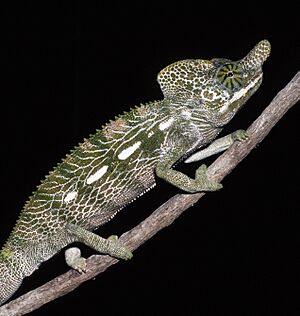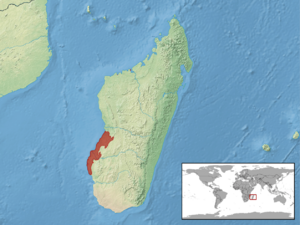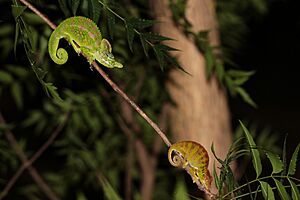Labord's chameleon facts for kids
The Labord's chameleon (Furcifer labordi) is a special type of chameleon. It is a lizard that belongs to the Chamaeleonidae family. You can only find this chameleon in the dry forests of western Madagascar. These forests include spiny forests. Sadly, this chameleon is considered vulnerable. This means its home is shrinking, which puts it at risk.
Quick facts for kids Labord's chameleon |
|
|---|---|
 |
|
| male | |
| Conservation status | |
| Scientific classification | |
| Genus: |
Furcifer
|
| Species: |
labordi
|
 |
|
What's in a Name?
The name labordi honors a French adventurer named Jean Laborde. He was a very interesting person!
Labord's Chameleon Life Cycle
Labord's chameleons are unique. They are the only chameleons known to usually live for only about one year. The adult chameleons die after they have laid their eggs. This is called being semelparous. It means they have one big chance to reproduce in their lives. Some other chameleon species might also do this, but it's most clear with Labord's chameleon.
The shortest lives for these chameleons happen in very dry areas. In these places, all the eggs hatch at the same time. This happens at the start of the wet season in November. They grow very fast after hatching. By January, they are adults and ready to breed.
Between late January and late March, the female chameleons lay their eggs in the ground. These eggs will hatch in the next wet season. After laying eggs, all the adult chameleons die. In these dry areas, they only live for about 4 to 5 months after hatching. This is the shortest life recorded for any tetrapod vertebrate. A tetrapod vertebrate is an animal with a backbone and four limbs, like chameleons.
In places with more rain, the chameleons live a bit longer. They hatch about a month earlier. Their lives after hatching are usually 6 to 9 months long. They take a little longer to grow up. Some females in these areas might even lay eggs twice in one wet season. Very rarely, a female might live through the dry season. She could even survive into the next breeding season, living for more than a year.
Male chameleons have a tougher time. They fight a lot to find a mate. They often don't eat for days while guarding a female. In the wild, males always die after the breeding season. But if they are kept in a safe place and don't have to fight, males can live as long as females. Sometimes, they also live for more than a year.



